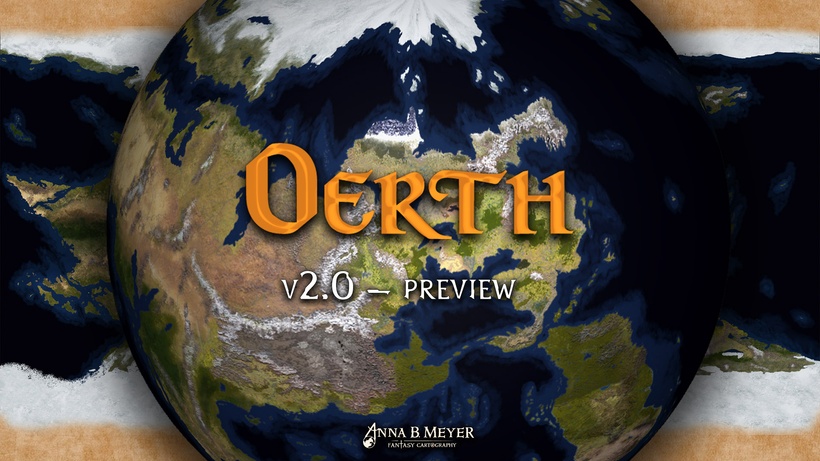
I've been gaming in Greyhawk for 40 years now, and been very interested in the geography of the setting from the time I first opened the box and saw the Darlene map. Strangely my interested of the geography beyond the Flanaess was very limited for the most of these four decades. The main reasons are lack of information and the few tidbits I've come across so far have been underwhelming, from bad maps to un-creative names (to say it diplomatically).
As my Greyhawk mapping project have grown in detail and scope the need to place the Flanaess on the globe, if the world of Greyhawk is set on a planet which most of the lore seems to suggest, have grown more and more. When I started my foray into trying to understand the planet Oerth better it was with this limited goal of placing the Flanaess, the rest I was keen on staying away from. The lore and the tension around it I felt an urge to stay out of. Now after about 5 years of cautiously and at first reluctantly trying to build an understanding of the Oerth, it have drawn me into a whole new level of fantasy worldbuilding that I have come to love.
In 2021 I presented my first generation of Oerth maps, that you can find here: https://www.annabmeyer.com/oerth-test/. Now it is time go learn from that initial attempt and create something more useful, more detailed and to try and better inspire Greyhawk gamers to venture outside of the Flanaess.

At Virtual Greyhawk Con last year I presented the map above with the areas I wanted to focus on and improve in the next generation of my Oerth Project. Fireland, Blackmoor, west of Sea of Dust, western Dramidj ocean, central Oerik, and the large isle at the NW edge of Oerik. Fireland was included on this list anticipating a Fireland source book from CASL Entertainment. Blackmoor with the goal of making it more compatible with Dave Arneson's Blackmoor campaign and generally more interesting and appealing (in a geographic sense, still cold and uninviting!) The lands west of the Sea of Dust had some issues with mountain ranges and layout I felt waw too ad-hoc and needed some tlc. The western Dramidj and central Oerik needed attention both for it being an area great to include geography matching other settings (more on that later) and also to adjust it as part of my findings when working on Hot and Cold Oerth variants. The far western "triangle" need some more work to make it less of a triangular extension.

Fireland I haven't touched yet, i want to leave it as a placeholder until CASL publish the sourcebook for it to not create a competing geography. Blackmoor has more of an interesting coast and more of the rivers now flow into it. Western Dramidj has been more altered to include both the geography from Lankhmar and the Gaxx Worx setting of Okkorim. This is not product placement. I'm doing it both as a way to show how large the Oerth is and it can include multiple settings of various nature, and also as a way to make the planet more interesting and useful. Further west there is also a rectangle marking an area in the central Oerik, that is where I placed the terrain of the Dark Sun setting. Our Flanaess are huge compared to these other settings that cover only a fraction of the size.

Still a lot of work to do before I feel my model is good enough but this is a significant step in the right direction, and it fulfilled my initial goal, placing the Flanaess on Oerth. The map below shows both summer and winter versions with polar views as well. Orthographic projections (as seen from space) are in my opinion the way to go as they show a realistic view of areas. Real world maps have often navigation needs with requires other projections, that are angular correct for example, or focus on a particular region. There might be a need to establish a Flanaess Projection as a standard for my Greyhawk mapping centered on that region of Oerth. That would be useful for hex and other overlays, with the drawback that they would be regional. Ortho based projections are global in nature and might be the best option for using a standard that can be used globally. That is something we have to test and very in the coming year or so.

Global climate is interesting and important not only in the real world, it is equally of great interest for me in my fantasy worldbuilding. It adds a crucial layer of understanding when it comes to who and what lives (or dies) in a region, what an area looks like and as an input for history and scenario planning.
